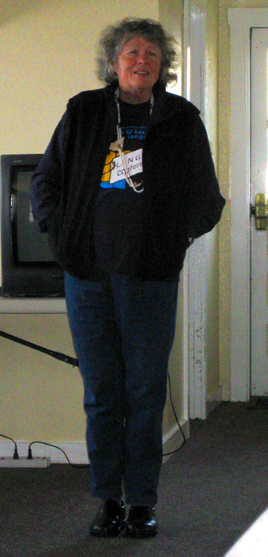Related Research Articles
Ethnologue: Languages of the World is an annual reference publication in print and online that provides statistics and other information on the living languages of the world. It is the world's most comprehensive catalogue of languages. It was first issued in 1951, and is now published by SIL International, an American evangelical Christian non-profit organization.

An endangered language or moribund language is a language that is at risk of disappearing as its speakers die out or shift to speaking other languages. Language loss occurs when the language has no more native speakers and becomes a "dead language". If no one can speak the language at all, it becomes an "extinct language". A dead language may still be studied through recordings or writings, but it is still dead or extinct unless there are fluent speakers. Although languages have always become extinct throughout human history, they are currently dying at an accelerated rate because of globalization, mass migration, cultural replacement, imperialism, neocolonialism and linguicide.
Linguistic anthropology is the interdisciplinary study of how language influences social life. It is a branch of anthropology that originated from the endeavor to document endangered languages and has grown over the past century to encompass most aspects of language structure and use.

SIL International is an evangelical Christian nonprofit organization whose main purpose is to study, develop and document languages, especially those that are lesser-known, in order to expand linguistic knowledge, promote literacy, translate the Christian Bible into local languages, and aid minority language development.
Language revitalization, also referred to as language revival or reversing language shift, is an attempt to halt or reverse the decline of a language or to revive an extinct one. Those involved can include linguists, cultural or community groups, or governments. Some argue for a distinction between language revival and language revitalization. There has only been one successful instance of a complete language revival, the Hebrew language, creating a new generation of native speakers without any pre-existing native speakers as a model.

In linguistics, language death occurs when a language loses its last native speaker. By extension, language extinction is when the language is no longer known, including by second-language speakers, when it becomes known as an extinct language. A related term is linguicide, the death of a language from natural or political causes, and, rarely, glottophagy, the absorption or replacement of a minor language by a major language.

The Linguistic Society of America (LSA) is a learned society for the field of linguistics. Founded in New York City in 1924, the LSA works to promote the scientific study of language. The society publishes three scholarly journals: Language, the open access journal Semantics and Pragmatics, and the open access journal Phonological Data & Analysis. Its annual meetings, held every winter, foster discussion amongst its members through the presentation of peer-reviewed research, as well as conducting official business of the society. Since 1928, the LSA has offered training to linguists through courses held at its biennial Linguistic Institutes held in the summer. The LSA and its 3,600 members work to raise awareness of linguistic issues with the public and contribute to policy debates on issues including bilingual education and the preservation of endangered languages.
Hawaiʻi Sign Language or Hawaiian Sign Language, also known as Hoailona ʻŌlelo, Old Hawaiʻi Sign Language and Hawaiʻi Pidgin Sign Language is an indigenous sign language native to Hawaiʻi. Historical records document its presence on the islands as early as the 1820s, but HSL was not formally recognized by linguists until 2013.
The Endangered Language Fund (ELF) is a small non-profit organization based in New Haven, Connecticut. ELF supports endangered language maintenance and documentation projects that aim to preserve the world's languages while contributing rare linguistic data to the scientific community.
An indigenous language, or autochthonous language, is a language that is native to a region and spoken by its indigenous peoples. Indigenous languages are not necessarily national languages but they can be; for example, Aymara is both an indigenous language and an official language of Bolivia. Also, national languages are not necessarily indigenous to the country.
Language documentation is a subfield of linguistics which aims to describe the grammar and use of human languages. It aims to provide a comprehensive record of the linguistic practices characteristic of a given speech community. Language documentation seeks to create as thorough a record as possible of the speech community for both posterity and language revitalization. This record can be public or private depending on the needs of the community and the purpose of the documentation. In practice, language documentation can range from solo linguistic anthropological fieldwork to the creation of vast online archives that contain dozens of different languages, such as FirstVoices or OLAC.
Terralingua is a 501(c)(3) non-profit organization under U.S. tax law (#38–3291259) and a registered non-profit society in Canada based on Salt Spring Island in Vancouver, British Columbia whose mission is to support the integrated protection, maintenance and restoration of the biocultural diversity of life. Created in 1996, Terralingua's founders Luisa Maffi and Dave Harmon pioneered the concept and field of Biocultural Diversity, building on emergent ideas about the links between biological and cultural diversity.

Leanne Hinton is an American linguist and emerita professor of linguistics at the University of California at Berkeley.
Emiliana Cruz is a contemporary linguistic anthropologist. She received her doctorate in linguistic anthropology from University of Texas at Austin and currently teaches at CIESAS-CDMX. She is the co-founder of the Chatino Language Documentation Project.
Colleen M. Fitzgerald is an American linguist who specializes in phonology, as well as language documentation and revitalization, especially with Native American languages.

Margaret Florey is an Australian linguist whose work focuses on the revitalization and maintenance of Indigenous Australian languages. She has documented changes in contemporary speech, such as the expression Yeah, no which is becoming more prevalent in Australia.
The Institute on Collaborative Language Research or CoLang is a biennial training institute in language documentation for any person interested in community-based, collaborative language work. CoLang has been described as part of a modern collaborative model in community-based methodologies of language revitalization and documentation.
Canadian Indigenous Languages and Literacy Development Institute (CILLDI) - an intensive annual "summer school for Indigenous language activists, speakers, linguists, and teachers" - hosted at the University of Alberta, Edmonton - is a "multicultural, cross-linguistic, interdisciplinary, inter-regional, inter-generational" initiative. CILLDI was established in 1999 with one Cree language course offered by Cree speaker Donna Paskemin. By 2016 over 600 CILLDI students representing nearly 30 Canadian Indigenous languages had participated in the program and it had become the "most national of similar language revitalization programs in Canada aimed at the promotion of First Peoples languages." CILLDI - a joint venture between the University of Alberta and the University of Saskatchewan - responds to "different sociolinguistic situations in language communities under threat" and includes three faculties at the University of Alberta in Edmonton - Arts, Education, and Native Studies. CILLDI provides practical training to students which is "directly implemented back in the community." Initiatives like CILLDI were formed against the backdrop of a projection of a catastrophic and rapid decline of languages in the twenty-first century.
The Endangered Languages Project (ELP) is a worldwide collaboration between indigenous language organizations, linguists, institutions of higher education, and key industry partners to strengthen endangered languages. The foundation of the project is a website, which launched in June 2012.

Durbin Feeling was a Cherokee Nation linguist who wrote the primary Cherokee–English dictionary in 1975. He is considered the greatest modern contributor to the preservation of the endangered Cherokee language.
References
- ↑ Perlin, Ross (2024-02-22). "Disappearing tongues: the endangered language crisis". The Guardian. ISSN 0261-3077 . Retrieved 2024-02-25.
- ↑ De Freytas-Tamura, K. (2020). Just 700 Speak This Language (50 in the Same Brooklyn Building). International New York Times.
- 1 2 ""The Endangered Language Alliance" www.languagemagazine.com. 26 July 2022. Accessed 10 November 2023". Archived from the original on 26 September 2023. Retrieved 10 November 2023.
- 1 2 ""The Endangered Language Alliance" www.elalliance.org. Accessed 10 November 2023". Archived from the original on 14 June 2013. Retrieved 10 November 2023.
- ↑ Carter, W. (2016). Should Endangered Languages Be Saved?. Anthropology News, 57(6), e73-e75.
- 1 2 3 Mask, Dierdre (February 19, 2024). "How to Speak New York". The New York Times . Retrieved February 25, 2024.